Brauncastel
Brauncastel | |
|---|---|
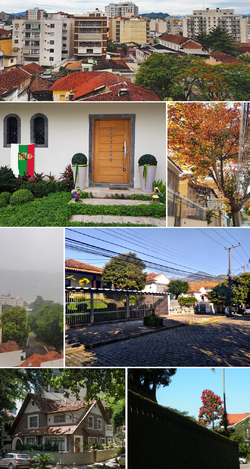 From top to bottom, left to right: Panorama of Malmünd whereabouts as seen from the Meyer Annex, the Western Gardens including the famous Autumn Tree in the Western Borough, the Princess of Triunphus Ave. and the Dona Maria St. in the Northern Borough, the Rochesburg Palace and the Elidian Walls in the Southern Borough. | |
| Mottoes: Vivre et laisser vivre Live and let live | |
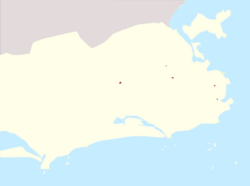 Location of Brauncastel (red) within the Brazilian municipality of Rio de Janeiro (yellow). | |
| Country | |
| Region | Riviera |
| Historic countries | Brazil Roschfallen |
| House of Bruyn | 12 October 1876 |
| Inc. Roschfallen | 28 January 2014 |
| Ebenthal capital | 13 August 2014 |
| Borders altered | 29 December 2019 |
| Province status | 5 February 2022 |
| Founded by | Arthur van der Bruyn and Arthur Beato |
| Government | |
| • Type | Executive-led devolved administration |
| • Chief Executive | The Baron of Roches |
| • Councillors | Thiago Walker Wellington Muniz |
| Area | |
| • Total | 2.5 km2 (1.0 sq mi) |
| • Water | 0 km2 (0 sq mi) 0% |
| Elevation | 51 m (167 ft) |
| Population (2022) | |
| • Total | 36 (permanent) |
| • Rank | 1st in Ebenthal |
| Demonym | Brauncastellian |
| Time zone | UTC−3 |
| Postal Code | 20000-001 to 23799-999 |
| Area code | +55 21 |
| HDI (2022) | 0.959 very high (2nd) |
| GDP (2022) | 𝒦ℳ 195.000 |
| Per capita | 𝒦ℳ 5.416 |
| Primary Airport | Rio de Janeiro/Galeão International Airport |
| Primary Road | Princess of Triunphus Ave. |
| Primary Rail | Méier Station |
Brauncastel (German pronunciation: [bɾˈa͡ʊnkastəl]), formerly named Arturia (2014–2020), Altenburg (2020–2022) and Malmünd (2022-2024) and sometimes jokingly called City of Many Names, is the capital and most populous municipality of Ebenthal, located in the southern region of the country known as the Ebenthaler Riviera. With 2.5 km² and 36 permanent residents, the municipality is made up of multiple enclaves entirely landlocked by the Brazilian metropolis of Rio de Janeiro. It is administered through an executive-led devolved government by a Chief Executive appointed by the King of Ebenthal, and is represented in the House of Councillors by three elected member. As the capital of a great power within the Brazilian micronational sector, Brauncastel exerts a considerable deal of influence not only in national politics, but in the sectoral political, financial and cultural scenarios.
Prior to the European colonization of the Americas, the territory comprising Brauncastel was inhabited by the Tupi tribes known as Temiminós and the Tamoios. At the beggining of Portuguese colonization, the municipality of Rio de Janeiro was established in 1565 within the colonial State of Brazil. The region remained part of the municipality for almost two centuries following Brazil's independence, during which time the Bruyn and Beato families acquire properties within the city. In 2014, the micronationalists Arthur van der Bruyn, who had just founded the Kingdom of Roschfallen, and Arthur Beato, proclaimed the secession of the their respective families' properties in Rio de Janeiro and merged them into a new municipality called Arturia, then part of the metropolitan area of Triunphus, which served as Roschfallen's capital. However, half a year later, amidst of a deep constitutional crisis, Arthur Beato proclaimed the independence of his properties and founded the Kingdom of Ebenthal, declaring his family's properties in Rio de Janeiro – the town of Arturia – as the capital of the new monarchy. However, following the overthrew of the House of Beato in the aftermath of the Mateusian Crisis and the rise of the Arthur van der Bruyn to the throne of Ebenthal, the municipality borders incorporated the Bruyn holdings and lost the Beato properties, being renamed the following year as Altenburg, a name it has retained until late 2022.
Home to the largest gross domestic product in Ebenthal, Brauncastel is the municipality that contributes the most to the Ebenthaler economy, providing the country with the largest percentage of its revenue through its broad services sector. The city alone accounts for between one-fifth and one-sixth of the national GDP and is the main hub for multinationals serving Ebenthal, in addition to playing the role of the country's cultural and scientific center. The city serves as the home of financial institutions such as the Bank of Ebenthal and the Conference of Santiago Financial Authority, cultural institutions such as the Royal National Library and the Gems and Rocks Museum and scientific ones, such as the Zweig Institute and the PLANET, including the Bubbington Observatory, in addition to housing the José Pedrosa Stadium.
Etymology
Brazilian Empire 1876–1889
Fed. Rep. of Brazil 1889–2014
King. of Roschfallen Jan–Aug 2014
Kingdom of Ebenthal 2014–present
The name "Brauncastel" is an agglutination of the German words braun (brown) and castel (castle), the latter coming from Old High German, appropriating the word latina castellum. Literally, Brauncastel translates to "Brown Castle", however in this case Braun is a Germanization of the name Bruyn, brown in Dutch, and family name of the reigning Monarch's royal house, the House of Bruyn. The meaning of the name of the municipality is therefore "Castle of the Bruyn". The city gained its name with the adoption of the Ebenthaler Constitution of 2024 on 18 February. The germanization of Bruyn took place in order to maintain cohesion with the nation's German-Brazilian culture.
Historically the city was also named Arturia, meaning "City of Arthur", in honor of the town's founders and Kings of Ebenthal, from 2014 to 2020. The city was later renamed to Altenburg, but as that name was a combination of German toponymys Alten and Burg, which could literally translates in Portuguese to "Quinta Velha", the name of an allied micronation, the Luso-Germanic Cultural Commission advised the government to change the city's name, which was done with the adoption of the name Malmünd, later dropped in favor of Brauncastel since Malmünd had been chosen solely for aesthetics and the name does not have a meaning related to the micronation.
History
Pre-micronation

Prior to the beginning of the European colonization of the Americas, the territory comprising modern Brauncastel was inhabited by indigenous tribes of the Tupi ethnic group, such as the Temiminós and the Tupinambás, and by ethnic tribes Macro-Jê such as the Maxakalí and the Krenak. Europeans first arrived in the region in 1502, and from 1555 they settled, initially with the Frenches and later the Portuguese, who in 1565 founded the city of Rio de Janeiro, part of the Portuguese colonial State of Brazil that had been established in 1549. On 27 January 1763, the colonial administration of Portuguese Brazil was moved from Salvador to Rio de Janeiro. The city remained primarily a colonial capital until 1808, when the Portuguese Royal Family and most of the associated Lisbon nobles, fleeing from Napoleon's invasion of Portugal, moved to Rio de Janeiro.
After the definitive defeat of Napoleon in 1815 in the Hundred Days campaign, the court of the Queen Maria I of Portugal decided to remain in Rio de Janeiro, instead of returning to Lisbon, the colony was elevated to the rank of Kingdom of Brazil, a constituent state of the United Kingdom of Portugal, Brazil and the Algarves. The city continued as the capital of the pluricontinental Lusitanian monarchy until 1822, when, a year after the return of the Royal Family to Portugal, Pedro, Prince Regent of Brazil and heir to the Lusitanian thrones, proclaimed the independence from the kingdom and was subsequently acclaimed first Emperor of Brazil. During the almost seven decades that the independent Brazilian monarchy lasted, Rio de Janeiro evolved to become one of the main capitals of the world and a pioneer in several areas, such as the installation and treatment of modern sewage . After the republican coup d'état in 1889, the city became the capital of the Republic of the United States of Brazil until 1960, when it lost its status with the transfer of the Brazilian capital to Brasilia
Bruyns and Beatos moved in
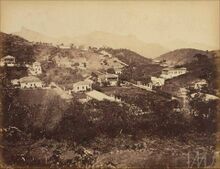
During the heyday of the Brazilian Empire, coinciding with a long and slow period of decline of the Portuguese monarchy, the Portuguese José Pedrosa and his wife Maria Martins da Costa immigrated from Porto to Rio de Janeiro, where in 1876 they acquired a small farm in the neighborhood of Botafogo. His daughter, Justina Martins Marques, married in the city in 1890 with the also Portuguese Manoel Marques Barbosa, and the couple returned to Portugal only to, after Manoel's death in 1899, Justina and her five children return to Rio de Janeiro in definitive, inheriting her parents' farm and transforming it into a tenement and a village. In 1946 Justina's granddaughter, Lindalva de Souza Saboia, an illegitimate descendant of the King Victor Emmanuel II of Italy, married Mário van der Bruyn, 4th Baron of Roches, and From then on, his descendants, part of the House of Bruyn, began to occupy the tenement and the village, which the family still owns today, and where Armando, 5th Baron of Roches, Head of the House of Bruyn.
In the same period, at the beginning of the 20th century, Setúbal Beato, a merchant son of a Portuguese immigrant who left the island of Madeira in 1919, bought a farm in the region of Méier, where he built a small village of houses called Villa Beata, eventually acquiring two other houses attached to the village that served as a residence not only for his family, but for families of workers from the Central Railroad of Brazil. Eventually, and mainly from the 1970s onwards, with the automation of the train systems and the growth of the House of Beato, the workers moved to make way for the broad descendants of Setúbal who continue to live in the village as of 2019.
Founding Arturia

On 28 January 2014, on his 16th birthday, Arthur van der Bruyn, son and heir of Armando van der Bruyn, 5th Baron of Roches and Head of the House of Bruyn, proclaimed independence of his father's and stepfather's estates and founded the Kingdom of Roschfallen, of which he proclaimed himself King. The estates of his father and stepfather, of which he is heir, were then divided to form the municipality of Triunphus, capital of Roschfallen, and another municipality not defined at the time. Arthur van der Bruyn, now King Arthur I of Roschfallen, was a friend and neighbor of Arthur Beato, great-grandson of Setúbal Beato. Both had participated together in simulationist projects on the NationStates platform, from which they ended up coming into contact with micronationalism. Eventually, Bruyn convinced Beato to participate in Roschfallen's government, and appointed him Captain-Regent (head of government) of Roschfallen and created him Duke of Gallar. For this, Bruyn demanded that Beato hand over the sovereignty of his family's properties to the Roschfallenian State, to be incorporated into the micronation, to which Beato agreed. Due to the geographical proximity of the Beato estates and the part of the Bruyn estates not integrated into Triunphus, both agreed that their estates should jointly form a single administrative unit, thus creating the county of Arturia, named after it by Arthur Beato's mother in homage to the micronationalists and friends of the same name.
Not long after the foundation of Arturia however, seeking to maximize the image of Roschfallen, King Arthur I chose to create several municipalities and dismembered his properties from the municipality of Arturia, integrating them into the national capital Triunphus. Arturia, in turn, continued to exist in the form of the House of Beato estates and was reduced to a satellite city and formal part of the metropolitan region of Triunphus.
Ebenthaler capital
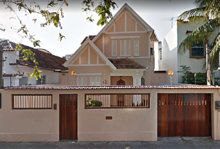
In July 2014, a political process began in Roschfallen that would culminate in a revolution in August. Arthur Beato, 1st Duke of Gallar, who had been appointed High Commissioner of Gros Morne, a department formed by properties belonging to his family and the Bruyn after leaving the Captaincy-General of the country, supported by other figures of politics and the nobility, began to clash with King Arthur I about the structural administrative development of Roschfallen; the monarch, acting authoritatively, wanted to transform the country into an absolute monarchy and did not listen to parliament and its advisors. In retaliation for the Duke of Gallar's criticism, Arthur I announced the annexation of the county of Arturia by Triunphus. The decree, however, had no practical effect, as the citizens of the portion of Arturia whose properties belong to the Beato family did not express their opposition. As the conflict escalated, on 11 August 2014 the Duke of Gallar proclaimed the independence of his family's estates from Roschfallen and established the Kingdom of Ebenthal, of which Arturia officially became the capital two days later.
As the capital, Arturia became the center of the country's administration, but also the main target of attacks perpetrated by Ebenthal's enemies. In 2017, during the Ebenthaler Civil War, the city was directly affected when Nilo Moreira, 1st Count of Versteckburg, who had proclaimed himself King Nilo I, leaked personal information of several residents of Arturia on the internet, causing chaos and commotion among the population and demands on municipal and national government authorities. Later, in 2019, in the context of the Mateusian Crisis, the ancient frontier of Arturia was pulverized with the overthrow of King Mateus I and the end of the reign of the House of Beato, which stripped the administrative entity Arturia of any physical-geographical territory, and the seat of administrative power has been temporarily moved to Erzfelsen. Only on 29 December 2019, with the accession of the former King of Roschfallen Arthur van der Bruyn to the throne of Ebenthal as Arthur II, the municipality gained new territories and a new border, incorporating the properties of the House of Bruyn in Rio de Janeiro. The entire process took place according to the precepts of Nomadic Micronation Theory, which was formally developed for this specific purpose, later being applied in many other cases.
Under the reign of a new dynasty, on 18 August 2020 King Arthur II issued an edict changing the name of the capital of Arturia to Gillisburgh, meaning "city of Gillis", a homage to the House of Bruyn's forefather Gillis van der Bruyn, and as a mean to give the city a more neutral and less egocentric name, thus not offending any potential future monarch. However, and without the knowledge of the monarch, the parliament of Ebenthal, which should have validated the decree after consultation with the municipal authorities of Arturia, did so but under the name of Altenburg, which had been considered as the new name for the capital, and not Gillisburgh, so that the town, although popularly and widely called Gillisburgh, was officially called Altenburg. That question was finally resolved when on 5 February 2022, as the King believed that having a city named after an ancestor made it too personal and could still be interpreted as a sign of self-centeredness, he issued a decree [redundant] with force of law officially naming the city "Free City of Altenburg". However, on 1 January 2023, the city's name was changed once to "Malmünd" in light of the approval of a major reform package approved by the government on 23 December 2022.
Geography

Brauncastel is located on the far western part of a strip of South America's Atlantic coast, close to the Tropic of Capricorn. Facing largely south, the total territory of the municipality consists of about 2.5 km² and comprises a series of small enclaves and exclaves entirely surrounded by the Brazilian municipality of Rio de Janeiro. These enclaves are made up entirely of private property owned for the most part by members of the Royal Family, including the King himself and his father Armando, 5th Baron of Roches, of whose properties King Arthur II is the major heir. The terrain on which the city is located varies, but it is estimated that three-fifths or circa 60% of the terrain is located on slopes and small hills, and the remaining two-fifths or cicrca 40% of the territory is located directly at sea level. There are no natural bodies of water and the city is not bathed by the sea. Brauncastel's level of urbanization is absolute, and the state subsequently classifies the municipality as a "micrometropolis", this is, a metropolis when considering the level of micronational cities.
City districts
Brauncastel is subdivided in three boroughs, each one made of one or more enclaves within three different regions of Rio de Janeiro.
- The Northern Borough: Consists on two enclaves in the Méier neighbourhood of Rio de Janeiro.
- The Southern Borough: Consists on three enclaves in Botafogo, Santa Teresa and Laranjeiras neighbourhoods of Rio de Janeiro.
- The Western Borough: Consists on one enclave in Taquara neighbourhood of Rio de Janeiro.
Environment
Due to the very high level of urbanization of Brauncastel, the municipality is not served by natural environments such as forests and rivers, but in the Southern and Western boroughs the city borders areas of Atlantic Forest of the surrounding Rio de Janeiro. The city has, on the other hand, green areas such as parks and gardens well wooded and with a variety of tropical plants native to the Atlantic Forest, and also has artificial bodies of water such as swimming pools.
Brauncastel is not a major producer of pollution, and although it suffers from pollution from the neighboring city, mainly due to the altitude and geographical location of the enclaves that make up the city, the level of pollution is negligible.
Climate
Brauncastel has a tropical savanna climate (Aw) that closely borders a tropical monsoon climate (Am) according to the Köppen climate classification, and is often characterized by long periods of heavy rain between December and March. The city experiences hot, humid summers, and warm, sunny winters. Close to the coast, the breeze, blowing onshore and offshore, moderates the temperature. Because of its geographic situation, the city is often reached by cold fronts advancing from Antarctica, especially during autumn and winter, causing frequent weather changes. In summer there can be strong rains, which have, on some occasions, provoked catastrophic floods and landslides. The city has had rare frosts in the past and occasional falls of ice pellets.
| Climate data for Malmünd | |||||||||||||
|---|---|---|---|---|---|---|---|---|---|---|---|---|---|
| Month | Jan | Feb | Mar | Apr | May | Jun | Jul | Aug | Sep | Oct | Nov | Dec | Year |
| Record high °C (°F) | 40.9 (105.6) |
41.8 (107.2) |
41.0 (105.8) |
39.3 (102.7) |
36.3 (97.3) |
35.9 (96.6) |
34.9 (94.8) |
38.9 (102) |
40.6 (105.1) |
42.8 (109) |
40.5 (104.9) |
43.2 (109.8) |
43.2 (109.8) |
| Average high °C (°F) | 30.2 (86.4) |
30.2 (86.4) |
29.4 (84.9) |
27.8 (82) |
26.4 (79.5) |
25.2 (77.4) |
25.0 (77) |
25.5 (77.9) |
25.4 (77.7) |
26.0 (78.8) |
27.4 (81.3) |
28.6 (83.5) |
27.3 (81.1) |
| Daily mean °C (°F) | 26.3 (79.3) |
26.6 (79.9) |
26.0 (78.8) |
24.4 (75.9) |
22.8 (73) |
21.8 (71.2) |
21.3 (70.3) |
21.8 (71.2) |
22.2 (72) |
22.9 (73.2) |
24.0 (75.2) |
25.3 (77.5) |
23.8 (74.8) |
| Average low °C (°F) | 23.3 (73.9) |
23.5 (74.3) |
23.3 (73.9) |
21.9 (71.4) |
20.4 (68.7) |
18.7 (65.7) |
18.4 (65.1) |
18.9 (66) |
19.2 (66.6) |
20.2 (68.4) |
21.4 (70.5) |
22.4 (72.3) |
21.0 (69.8) |
| Record low °C (°F) | 17.7 (63.9) |
18.9 (66) |
18.6 (65.5) |
16.2 (61.2) |
11.1 (52) |
11.6 (52.9) |
12.2 (54) |
10.6 (51.1) |
10.2 (50.4) |
10.1 (50.2) |
15.1 (59.2) |
17.1 (62.8) |
10.1 (50.2) |
| Average Rainfall mm (inches) | 137.1 (5.398) |
130.4 (5.134) |
135.8 (5.346) |
94.9 (3.736) |
69.8 (2.748) |
42.7 (1.681) |
41.9 (1.65) |
44.5 (1.752) |
53.6 (2.11) |
86.5 (3.406) |
97.8 (3.85) |
134.2 (5.283) |
1,069.4 (42.102) |
| Average relative humidity (%) | 79 | 79 | 80 | 80 | 80 | 79 | 77 | 77 | 79 | 80 | 79 | 80 | 79.1 |
| Average rainy days (≥ 1 mm) | 11 | 7 | 8 | 9 | 6 | 6 | 4 | 5 | 7 | 9 | 10 | 11 | 93 |
| Sunshine hours | 211.9 | 201.3 | 206.4 | 181.0 | 186.3 | 175.1 | 188.6 | 184.8 | 146.2 | 152.1 | 168.5 | 179.6 | 2,181.8 |
| Source: Brazilian National Institute of Meteorology (INMET).[1][2][3][4][5][6][7][8][9] | |||||||||||||
Politics
Government
Brauncastel is one of the total eleven administrative divisions and eight municipalities of Ebenthal. The city is administered as a executive-led devolved government headed by a Chief Executive appointed by the King of Ebenthal. The Chief Executive, in turn, governs the city with the aid of a small council of members of his nomination. Brauncastel exercises its provincial autonomy through organic laws and the master plan stipulated and enacted by the Chief Executive and subsequently approved by the national parliament. Due to its exclusive status as the national capital and seat of the monarchy, the administration of the city is directly influenced by the Royal Family.
Brauncastel provides three elected members to represent it in the House of Councillors. The city still showcases examples of direct democracy with the formal proposition of laws being regularly made by its citizens and being implemented by the provincial government. Issues directly relevant to the micronation itself are handled directly by the central government and, despite passing through the city, they rarely mobilize the action or intervention of the provincial government.
Embassies and consulates
Brauncastel is officially home to the embassies of:
 Sultanate of Harram
Sultanate of Harram Hanseatic and Confederate States of Achsen
Hanseatic and Confederate States of Achsen United Provinces of Mauritia
United Provinces of Mauritia Independent State of the New Southern Rhine
Independent State of the New Southern Rhine Empire of Karnia-Ruthenia
Empire of Karnia-Ruthenia
Demographics
Race and ethnicity

According to the Ministry of the Interior, there were 36 people residing in Brauncastel. The census revealed the following numbers: 28 white people (77.7%), 5 multiracial people (13.8%) and 3 black people (8.3%), with the absence of East Asian and South American Native populations. The population of Brauncastel is circa 60% female and 40% male
Brauncastel is the municipality of Ebenthal formed by the most enclaves, with a total of six different enclaves. It is also the most populous city in the country as of 2022.
Different ethnic groups contributed to the formation of the population of Brauncastel. The majority of the population of Brauncastel is of Portuguese descent, with a considerable percentage being only the 2nd generation born in South America. The entire population, however, is descended from Portuguese, however the identification of primary ancestry varies according to the racial formation of the families and the phenotypes of individuals. More than 25% of the population descends from Africans, mostly from Angola and Mozambique, who were brought to Brazil as slaves, while of these, 13.8% are also descended, in a next generation, from Europeans, mainly Portuguese of varied origin, but also from Germans.
Religion
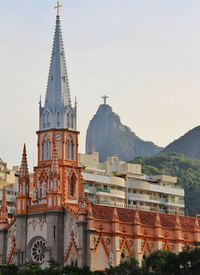
Religion in Brauncastel is somewhat diverse, with Catholic Christianity being the majority religion, followed by a large Spiritist population. According to the Ministry of the Interior, the population of Brauncastel had 22 Christians, that being of 20 Roman Catholics (55.5%) and 2 Protestant Evangelicals (5.5%), 12 Spiritists (33.3%) and 2 Atheists (5.5%).
Brauncastel has a rich and influential Catholic tradition inherited from Brazil, which was subsequently inherited from Portugal. Nevertheless, the Catholicism seen in Brauncastel is strongly influenced by Spiritism and shares with it beliefs such as reincarnation that are not observed by the Roman Church. Ebenthal and Ebenthaler catholics does not recognize or abide to the Igreja Católica Micronacional (En: Micronational Catholic Church). Protestantism and Atheism in Brauncastel, despite being professed, are often ostracized by other groups, the first for their often seen as prejudiced social postures, and the second for their disbelief and frequent discrediting of Christian religions, blaming on Catholicism and mocking on Spiritism, which are the two major religious denominations in the city.
Economy

Brauncastel has the largest nominal GDP of any city in Ebenthal and it is the province that generates the most income, approximately 𝒦ℳ 750.000, three times the annual revenue. Taking into consideration the network of influence exerted by the urban micrometropolis (which covers 17.8% of the population), this share in GDP is that of 18.20%. Subsequently the city has the second-largest GDP per capita in the country, that of 𝒦ℳ 20.833, surpassed only by New Switzerland as a administrative division and by none as a city proper. A fourth of the Ebenthaler economic power is concentrated on the city alone. The service sector is the biggest source of income for Brauncastel, which has a small industrial park and no agriculture. In services, work for international private companies (mainly of Brazilian origin) stands out, although there is a considerable number of public servants (and double shifts), and especially the self-employed microenterprise which is the flagship of the sector. In services, commerce (decoration, luxury items), IT, real estate, education, administration and provision of services stand out. The financial sector follows that of services, with the presence of national companies and international services offered, both employing residents of Malmünd.
The country's financial and political hub, Brauncastel is home to national public and private companies such as the Bank of Ebenthal, which is also the only bank formally allowed to operate in Ebenthal and deal with the Ebenthaler economy, and The Altenburg Express, the country's only newspaper. According to a study by the Ministry of the Interior, in partnership with the Ministry of Commerce, 19% of the population of Brauncastel makes up the upper middle class, or upper class, while the middle class makes up 78% of the population, and 3% are made up of the lower middle class and lower class. According to Central Government data, at least 37% of the province's economy comes from the upper class due to its higher level of education and easy access to high-level professions. The middle class, however, is still responsible for most of the provincial wealth production with 63%.
Infrastructure

Education
Brauncastel is home to the Zweig Institute, which is the only educational institution in the country, acting primarily as a supporting body for teaching general knowledge. The municipality is also home to the PLANET which, despite not being an educational institution per se, but a scientific research institution, provides educational instruction services for research purposes. Due to Ebenthal's geographic and financial limitations as a micronation, the country is unable to maintain a complex public education system. Nevertheless, the citizens of Brauncastel, all possessing dual Brazilian citizenship, make use of the public and private educational systems of the Brazilian surrouding State of Rio de Janeiro. The Brauncastelian government encourages the studies of its inhabitants in the best schools and universities outside its borders and carries out censuses and studies on the subject.
According to data from the Ministry of the Interior, Brauncasteld is the administrative division with the highest level of schooling among its inhabitants, with 86% of the adult population having completed or being in higher education. According to the Central Government, the main higher education institution attended by the Brauncastelians and the Ebenthalers in general is the Federal University of Rio de Janeiro. All children and adolescents in the city are duly enrolled in schools, the vast majority in the Brazilian private network.
Although both Portuguese and English are official languages of the country, Portuguese plays the role of national language and it is the native and primary language of all Brauncastelians. It is estimated that at least 30% of the city's inhabitants are proficient in English, which teaching is compulsory in all educational institutions attended by the Brauncastelians, such as Spanish language. However, the Italian and French languages are better known to Malmundians than Spanish for reasons of particular interest to the local population.
Transportation

Public transportation
Brauncastel owns and operates, through the Ministry of the Interior, a series of small unconnected roads called "micro-roads" by the Central Government, which are basically narrow cobblestone or dirt paths for the transport of pedestrians and small and medium-sized vehicles, usually linking the enclaves that make up the city to the neighboring municipality. Due to typical micronational limitations involving financial and geographic resources, Brauncastel does not have, therefore, a complex road system or any system of public transportation. The city is, however, served by the public transport system of the neighbouring foreign municipality, Rio de Janeiro; on the border between the municipalities is located the Méier Train Station that connects the heart of Brauncastel to that of Rio de Janeiro. Previously this rail system also provided a link between Brauncastel, Triunphus and Harram. Rio de Janeiro's bus lines are the main means of public transportation between the enclaves that make up Brauncastel, feeding the city's outskirts and connecting it to several neighbouring municipalities such as Rio de Janeiro, Niterói, Duque de Caxias, Nova Iguaçu, Magé and ultimatelly the Ebenthaler municipalities of Sanktstaat and Guterfolg, among others.
Cars
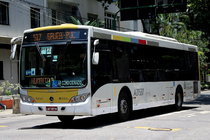
According to data from the government of Brauncastel, up to 70% of the population owns at least one car and uses it as the main means of transport between the enclaves that make up the city and also for work, the market. It is estimated that most of the cars in Brauncastel are from the Italian, Japanese and French Fiat, Toyota and Renault respectively. Data from the Ministry of the Environment indicate that there is only one electric car in Malmünd and the others are all combustion engines; the provincial government, however, stated that it expects to see an increase in the electric car fleet in the province over the next 10 years as well as the total replacement of gasoline as the main fuel for cars with natural gas for vehicles, which is more affordable but requires the installation of appropriate machinery. Statistically, the number of traffic accidents that occurred in Brauncastel is high, although their number is small: only three accidents, all without seriousness, of which two involved small knocks on walls and one being run over. In order to avoid more accidents and also encourage the reduction of pollution, the government encourages the replacement of cars by the public transport of the neighboring city as the main means of transport to work, and the replacement also by bicycles.
Bybicles
Although there was no census on the matter, the Brauncastelian government estimates that a considerable minority of the population, around 20%, makes frequent use of bicycles for leisure purposes and 5% uses it as a main means of transportation. The government publicly encourages the use of bicycles, especially after the creation of the Ministry of the Environment, as a way of stimulating the reduction of pollution through the reduction of carbon emission and reduction of local traffic and for its health promotion. In addition to private bicycles, Brauncastel also makes use of public bicycles in a partnership between the provincial government, the government of Rio de Janeiro and the Itaú Bank, with a bicycle rental unit of the bank installed in the side sidewalk of the Palace of Rochesburg with permission from Baron Armando, its owner and Viceroy of the Province.
Landmarks
Brauncastel is home to a large number of landmarks, points of interest and tourist attractions. It is the second largest tourist destination in the country in percentage terms, but it is the destination with the largest number and variety of tourist attractions, which move up to 1/8 of the provincial economy in the holiday seasons. According to the Ministry of the Interior in conjunction with the municipal government, the most visited landmark in Brauncasteland Ebenthal is Central Hill Castle, home of the Princess Élida of Ebenthal and the Heitor, Prince Royal, in the Southern Borough of the municipality. The castle includes the Elidian Walls, one of the main postcards of the city and Filipidian Lake, an artificial lake that is the main body of water in Brauncastel. In the city, two very important landmarks are also the Bubbington Palace, where the King resides, and the Palace of Rochesburg, seat of the municipal government. Also noteworthy are the Royal Library and the Bubbington Observatory, the José Pedrosa Stadium, the only football stadium in the city, and the Western Gardens.
Culture
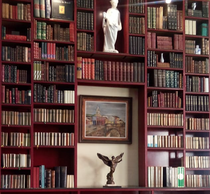


The Malmundian culture is a fac simile of the Carioca culture. Brauncastelian people, more commonly referred to as Arturians after the city's former name, have described themselves as pra frentex, an old slang meaning they're open-minded people regarding the social establishment and the adherence to modern practices and adoption of newer technology. The city's architecture ranges from Portuguese neoclassical to modern. Among Brauncastelian main points of interest are the Zweig Institute, the Bubbington Observatory, the Royal National Library and the Royal Ballet School.
Literature
Inheriting it directly from the House of Bruyn's elitism, consequence if its upbring in the rich zone of the city of Rio de Janeiro, the Brauncastelians quickly developed a European-style bourgeois cultural life. Brauncastel has been the hub of production of most, if not all Ebenthaler literature. Prince Mário Sérgio, King Arthur II's first cousin, has been the first recorded Ebenthali writer of success, writting and publishing several essays on Brazil's sociology and political history[11] pre-dating Ebenthal's existence and his position as a royal. Other distinguished authors are Jean Roberto, a king's friend who in 2015 published a horror book centered around a zombie apocalypse in Brazil and Armando, 5th Baron of Roches, who authored several poems and had some of them published in poetry books. Princess Heloise has also been a successful figure in Ebenthali literature, appearing in international (Brazilian) mainstream media giving interviews on her short works.[12]
In 2018 the Royal Fair of Arturia, a literary and social event organized by the House of Beato in partnership with the House of Bruyn, then the rulling house of Roschfallen, and the Al-Moraes Family of Barin, took place in the capital city then called Arturia, where many citizens and foreigners came together to exchange and talk about several books of their preference. More than 20 people participated and the fair disposed of more than a hundred books. Subsequently a survey carried out by the Chief Executive of Brauncastel himself concluded that the main literary style enjoyed by the Brauncastelian population is historical romance, followed by books and self-help and psychoanalysis, history, poetry and horror.
Music
The music exppression of Brauncastel is wide, ranging from the most listened genre of Brazilian Popular Music to Rock and Pop. Two rock bands has its origins in the city, although only one, the Efeito Colateral band, has been active professionally. A heavy and thrash metal band, Efeito Colateral has toured Brauncastel in an event sponsored by the Ministry of Culture and Education.[13] They have released an album so far and also performed in Barin. Malmünd is also home to the Maestro João Genúncio, King Arthur II's uncle (as husband to the writter Princess Heloise) who has performed twice in the country for a limited audience.
Theater
Due to the employment of Princess Élida of Ebenthal and her husband as principal dancers at the Rio de Janeiro Municipal Theater and Prince João Genúncio as conductor retiring from Brazilian Symphony Orchestra, the population of Brauncastel has developed a great appreciation for theatrical culture and is a frequent visitor to theaters inside and outside the city. Malmünd has only one theatre, the Royal Theater Élida van der Bruyn, located in the Central Borough and managed by Prince Élida. The theater also manages the Royal Ballet School and presents mainly ballet and children's plays. In addition, Royal Theater has already hosted presentations by maestro João Genúncio and other musical groups such as the band Efeito Collateral and the carnival group De Palhaço e Louco Todo Mundo tem um Pouco. According to data from the Ministry of Information, annually all Brauncastelians attend at least one theater hall, and it is estimated that about 70% of the population attends theaters with some frequency, usually following the career of the Princes of Ebenthal who are professional actors and ballet dancers.
International relations
Seat of organizations
From the election of King Arthur II of Ebenthal as Secretary-General of the Conference of Santiago in 5 January 2022, Brauncastel has served as de facto as the headquarters to the Conference of Santiago. The city is also headquarters the Micronational Trade Organization.
Twin towns – sister cities
Following the Conference of Santiago Sister Cities Program, Malmünd is twinned with:
 Persenburg, Karnia-Ruthenia
Persenburg, Karnia-Ruthenia Triunphus, Roschfallen
Triunphus, Roschfallen Barbarossa, New Southern Rhine
Barbarossa, New Southern Rhine Aldea de Pedro, Rino Island
Aldea de Pedro, Rino Island Klöw, Sildavia
Klöw, Sildavia Santiago do Sacramento, Quinta Velha
Santiago do Sacramento, Quinta Velha
See also
References
- ↑ "Temperatura Mínima (°C)" (in português). Brazilian National Institute of Meteorology. 1961–1990. Archived from the original on 8 August 2014. Retrieved 8 September 2014.
- ↑ "Temperatura Máxima (°C)" (in português). Brazilian National Institute of Meteorology. 1961–1990. Archived from the original on 8 August 2014. Retrieved 8 September 2014.
- ↑ "Temperatura Média Compensada (°C)" (in português). Brazilian National Institute of Meteorology. 1961–1990. Archived from the original on 8 August 2014. Retrieved 8 September 2014.
- ↑ "Precipitação Acumulada Mensal e Anual (mm)" (in português). Brazilian National Institute of Meteorology. 1961–1990. Archived from the original on 8 August 2014. Retrieved 8 September 2014.
- ↑ "Temperatura Mínima Absoluta (ºC)". Brazilian National Institute of Meteorology (Inmet). Retrieved 8 September 2014.
- ↑ "Temperatura Máxima Absoluta (ºC)". Brazilian National Institute of Meteorology (Inmet). Retrieved 8 September 2014.
- ↑ "Número de Dias com Precipitação Maior ou Igual a 1 mm (dias)". Brazilian National Institute of Meteorology. Archived from the original on 27 August 2014. Retrieved 8 September 2014.
- ↑ "Insolação Total (horas)". Brazilian National Institute of Meteorology. Archived from the original on 8 August 2014. Retrieved 8 September 2014.
- ↑ "Umidade Relativa do Ar Média Compensada (%)". Brazilian National Institute of Meteorology. Archived from the original on 8 August 2014. Retrieved 8 September 2014.
- ↑ The Clan Brum. Published on 8 December 2019. Retrieved on 1 January 2021.
- ↑ Fluminense Federal University. Cantareira by Mário Sérgio Brum. Published in 2001. Retrieved on 10 December 2020.
- ↑ "Bebezão Quatrocentão" (in português). O Globo. 2015. Archived from the original on 18 January 2015. Retrieved 5 July 2021.
- ↑ Efeito Colateral. Published on 2014. Retrieved on 30 December 2020.






